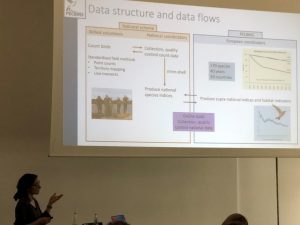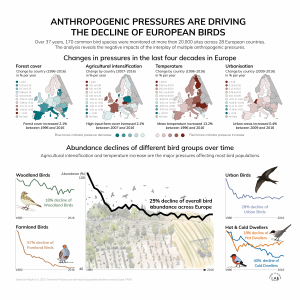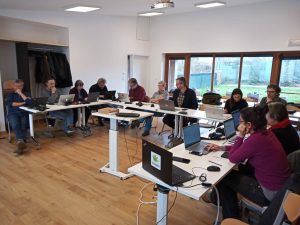Report on the Pan-European Common Bird Monitoring Scheme, September 2023
September 12, 2023
This report summarises the Pan-European Common Bird Monitoring Scheme (PECBMS) activities between 1 March 2023 and 1 September 2023.

The paper published in PNAS, based on the PECBMS data, showed how farmland practices are driving bird population decline across Europe, including the numbers of Skylark
Photo by Caroline Legg
Summary
We successfully delivered the EC tender and provided the Commission with three documents on Bird Indicators´ use in policy. Within the PECBMS coordination team, we have prepared a new strategy for 2023–2027, defined PECBMS´s mission and vision, and an action plan for the next five years to develop the scheme. We gathered national data from the national coordinators and checked them carefully to start supranational calculations. We updated the network with regular newsletters and web articles. In addition, we met EU stakeholders, researchers and coordinators regularly and provided answers and advice upon request. The scheme representatives attended several international meetings (EuropaBON, Biodiversa+) discussing the future of European biodiversity monitoring and PECBMS’s role in the new initiatives. In 2023, EBCC supported the International Census Plots programme in three countries, Serbia, Montenegro and Moldova, where common bird counts took place. In March, we organised the regular PECBMS Steering and Technical Group meeting to discuss the challenges and future progress of the scheme. In April, with ICO and CREAF, PECBMS organised a workshop Mapping the loss of farmland birds in the European Union, presenting the study outputs combining data from EBBA2 and PECBMS site-level data. Two papers were published based on the PECBMS data describing the declines of European birds due to farming practices and comparing temporal changes in abundance and biomass in the EU and UK.
Project funding
Until the end of April, the project was funded by the EC tender called “Technical and scientific support in relation to the delivery and development of wild bird indicators for the EU”. Unfortunately, afterwards, the routine PECBMS activities remain unsecured. However, we are now preparing a proposal for a new project to be submitted in September.
Scheme management
In April, we finished the project Technical and scientific support in relation to the delivery and development of wild bird indicators for the EU funded by the European Commission. We delivered the final report, including the three following documents:
- Frequently Asked Questions and Answers on Farmland Bird Index Targets in the Nature Restoration Law Proposal summarising the 15 most commonly asked questions and answers on the Nature Restoration Law proposal targets focused on the Farmland Bird Index to support the negotiations.
- A proposal of types of restoration measures needed to meet the Farmland Bird Index targets in the Nature Restoration Law summarising key actions recommended as restoration measures to improve the populations of common farmland birds as measured by the common Farmland Bird Index in each Member State and meet the target proposed in the Nature Restoration Law Proposal, Article 9.3.
- Costs of production of the national Farmland Bird Index in individual EU Member States describing the costs necessary for the annual running of the national bird monitoring schemes in EU Member States based on an online survey among the coordinators conducted from April to May 2023. We also pointed out the gaps in the funding system and the need for sustainable Farmland Bird Index production in the future, which the Nature Restoration Law proposal requires.
In the first half of 2023, the PECBMS team prepared a new PECBMS strategy for 2023–2027, summarising the main goals for the next five years. We identified the strengths and weaknesses, opportunities and threats, and compared them with a similar analysis made in 2014. Furthermore, we defined the PECBMS’s mission (the purpose of PECBMS) and vision (what is the ideal target state PECBMS wants to achieve) as follows:
PECBMS VISION: Europe has a healthy environment where birds matter. Biodiversity monitoring data are respected, used, smoothly processed and analysed within a happy, engaged, motivated, cooperative and supportive community. Monitoring schemes are secured and have skilled volunteers counting birds following the methods.
Motto: “Birds make us unique.”
Finally, we defined the action plan (how to achieve the goals) consisting of the steps, timetable, responsibilities, and budget needed and set the mechanisms to monitor the progress.

Looking for the proper wording for the PECBMS vision and mission
Gathering data for the production of European species trends and indices
The data collection started this year in early February, providing enough time for the coordinators to deliver datasets until 2022, before the start of the breeding season. We have regularly contacted coordinators during the data collection to help them with various issues regarding index calculation. We have collected and approved data from 22 countries; seven countries will be approved by the end of August, and one country was unable to deliver data. We will start supranational index calculation in September and plan to publish the update in October 2023.
Technical improvements
A new RTRIM-shell version based on comments gained from the national coordinators is under preparation. Thank you very much for your help with the RTRIM-shell improvement. We also improved a script for scheme combinations to calculate the supranational index.
Site-level data
In the last months, several data sets have been updated to data until 2022 (Brussels, Cyprus, Hungary, Ireland, Luxembourg, Romania and Wallonia). Other monitoring schemes have checked and completed the data validations.
Presentation of results and promotion
We informed the national coordinators and the wider audience, comprising 689 contacts, on the progress of the PECBMS via reports in the quarterly EBCC Newsletter (Spring and Summer issues 2023). We also released a special issue on 12 June asking for support for the proposed new EU legislation, Nature Restoration Law. All issues are available online on the pecbms.info website.

The three EBCC Newsletter issues released in March and June
PECBMS website www.pecbms.info has been actualised regularly. In the given period, we published five pieces of news and updated the list of publications, PECBMS methods, and information on the European bird monitoring schemes.
To address the wider public, we maintained the Facebook and Twitter profiles and updated the posts regularly every week – 26 news from 1 March until 1 September 2023.
The PECBMS team contributed to a brochure, Avifauna Monitoring Programs 2022 and Working Groups, published in June. It presents the outputs of monitoring in Spain, an update on several programs, such as SACRE (Spring bird trends), SACIN (Winter bird trends), Noctua (Nocturnal bird trends), Paser (Spring bird banding), Bird Phenology, or Winter Waterfowl Census.
On 2 March, Alena Klvaňová attended a Workshop on Biodiversity Monitoring Protocols Harmonisation Strategies organised by Biodiversa+ in Paris. She presented the PECBMS and explained the data flows within the scheme.

Alena Klvaňová presenting the PECBMS during the Biodiversa+ Workshop in Paris.

Anna Gamero presented the PECBMS project in the EuropaBON workshop in Troia.

Lluís Brotons presenting EBBA Live Farmland during the EuropaBON workshop in Troia.
Research
The PECBMS data has been used in several studies. We published a paper in PNAS in May with a team of authors from 28 European countries. The paper explored how species respond to increasing pressure by climate and land use changes. For the first time, we showed how 170 bird species have responded to major human-induced pressures at a continental scale.
Rigal S., Dakosa V., Alonso H., Auniņš A., Benkő Z., Brotonsf L., Chodkiewicz T., Chylarecki P., de Carlil E., del Moral J. C., Domșa C., Escandell V., Fontaine B., Foppen R., Gregory R., Harriss S., Herrando S., Husby M., Ieronymidou Ch., Jiguet F., Kennedy J., Klvaňová A., Kmecl P., Kuczyński L., Kurlavičius P., Kålås J. A., Lehikoinen A., Lindström Å., Lorrillièr R., Moshøj Ch., Nellis R., Noble D., Palm Eskildsen D., Paquet J.-Y., Pelissié M., Pladevall C., Portolou D., Reif J., Schmid H., Seaman B., Szabo Z. D., Szép T., Tellini Florenzano G., Teufelbauer N., Trautmann S., van Turnhout Ch., Vermouzek Z., Vikstrøm T., Voříšek P., Weiserbs A. and Devictor V. 2023: Farmland practices are driving bird population decline across Europe. PNAS https://www.pnas.org/doi/10.1073/pnas.2216573120

Changes in pressures on common European birds in the last four decades (from Rigal et al. 2023)
On 29 May, we published a paper in Phil. Trans. R. Soc. B. We modelled temporal change in species abundance and biomass by using extensive data on population sizes and trends of breeding birds in the UK and the EU. In addition, we explored how species’ population trends vary with species traits.
Gregory R. D., Eaton M. A., Burfield I. J., Grice P. V., Howard Ch., Klvaňová A., Noble D., Šilarová E., Staneva A., Stephens P. A., Willis S. G., Woodward I. D. and Burns F. 2023: Drivers of the changing abundance of European birds at two spatial scales. Phil. Trans. R. Soc. B 378: 20220198. https://doi.org/10.1098/rstb.2022.0198
Since March, we received two new data requests for the PECBMS site-level data. The first project is about the drivers of farmland birds and butterfly trends, and the second focuses on the effect of Green payments of CAP on biodiversity. We also delivered the final data set for the EBBA Live Farmland project in May to our colleagues from ICO-CREAF.
In July, the project report on „Mapping the loss of farmland birds in the European Union“ was completed and delivered to the JRC.
The International Census Plots (ICP)
The International Census Plots approach has been developed for countries and regions where capacity is insufficient to start full-scale national monitoring schemes or where other constraints prevent setting up such schemes immediately. Instead of setting up a larger number of census plots in each country individually, the census plots in ICP are set up in several countries at once, with fewer plots in each country. Thus, the set of plots will not produce data good enough to calculate reliable national population indices but should be good enough to generate indices representative of a broader region. As the monitoring will run at the ICP, capacity at the national level will be built, and the ICP will serve as a basis for the national schemes once the capacity is sufficient.
In 2023, EBCC supported ICP in three countries: Serbia, Montenegro and Moldova. While IPC has been running in Serbia for three years and was the second year of field surveys in Moldova, Montenegro started its participation in ICP in 2023. Data have been collated and checked, and we expect reports from the projects later in the Autumn. Further development and increase in participating countries is planned since 2024.
Maintain and update the network of cooperating organisations and individuals.
We provided advice and consultations to the national coordinators upon request.
16 March, France, Slovenia, Lithuania – We discussed RSWAN-combine updates
24 March, 14 April, Spain – We advised the coordinator on the composition of Spanish data and provided technical support regarding RTRIM-shell outputs
3 April, Malta – Discussing the pilot year of the common bird monitoring scheme to include the data in the PECBMS in the future 3–5 years
26 June, Greece – We advised the coordinator on the index calculation
28 July, Bulgaria – We advised the coordinator on the index calculation
On 13 April, the Catalan Institute for Ornithology (ICO), CREAF and the PECBMS organised a workshop Mapping the loss of farmland birds in the European Union, presenting the outputs of the study linking crop types and farmland intensity with farmland species trends and abundances. This work was done by combining data from EBBA2 and PECBMS site-level data. The workshop was held to inform the national coordinators of the monitoring scheme for using their data, and 16 coordinators attended.
Active communication with EU stakeholders
On 26 April, we met Kathrin Gebers, a new contact person in ESTAT, and introduced the PECBMS methods to start future collaboration.
PECBMS Steering and Technical Group Meeting
We report quarterly to the PECBMS Steering and Technical Group on the project’s progress.
On 10 March, the PECBMS Steering and Technical Group met via Zoom. The coordination team reported on the current state of the scheme. In addition, we discussed the scheme’s future development, like including new species in the PECBMS dataset or developing new bird indicators for, e.g., urban and mountain habitats.
Reporting to the EBCC Board
We regularly attended EBCC Board meetings: in person, on 20–23 March in Belgium, and a virtual Annual General Meeting on 27 April and 29 June. We presented the PECBMS progress and main outputs for the given periods.

EBCC Board meeting in March held in Belgium, hosted by Aquascope Virelles